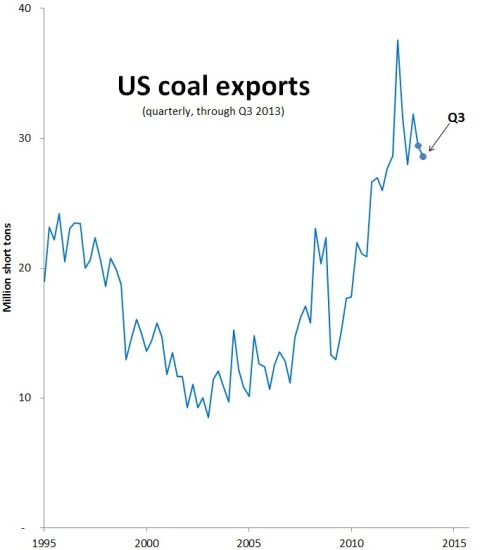The US Department of Energy just released new figures in its latest coal export report. Here’s what happened up through September 2013:
Nationally, coal exports continued to tail off. Still, the US shipped nearly 28.6 million tons of coal in the third quarter of 2013. It’s a lot by historical standards.
The Western Customs Region, center stage in the ferocious debate over expansion capacity, is currently only a minor player in the national coal exports scene. In the third quarter of 2013, the West Coast exported about 2.3 million tons, almost exactly the same volume as in the previous quarter.
The biggest role in western coal exports belongs to the Seattle District—entirely accounted for by coal traveling north from Washington into British Columbia for onward shipment to Asia—where exports declined slightly to about 1.2 million tons. In its third quarter investor report, Cloud Peak Energy claimed responsibility for 1.3 million tons of coal exported to Asia, which implies that Cloud Peak coal accounts for all of the coal moving through Seattle en route to BC terminals for export.
Coal exports remained flat in the Los Angeles District (from LAXT at Long Beach) and declined a bit in the Anchorage District (from the Seward Coal Loading Facility). In the San Francisco District, an area that has in recent years registered virtually no coal movements, exports shot up to nearly 500,000 tons.
Bear in mind that there are serious questions about the accuracy of the official government coal export numbers. For more about these inconsistencies, please read this post.
The EIA is promising final 2013 data in March for individual customs districts, and I’ll report on it here when it’s available.
All figures in this post are given in short tons unless otherwise noted. All of my reporting on quarterly coal export volumes can be found in the series “Coal Export Trend Reports.” All data come from the US EIA’s latest quarterly coal report, covering the entire Western Customs Region. In addition to the districts shown on the chart here, the Western Region includes the Portland, Honolulu, Nogales, and San Diego Districts. These districts have been reporting virtually no coal exports.
Please note: The second chart shows Customs Districts, not individual ports. The Port of Seattle, for example, does not move coal.










Bob Aegerter
Are the Power River Basin exports passing through Washington to Canada making a profit for their originators or are they a part of long term commitments that must be honored at a loss?
Harve
Yo,
Sounds like coal is on its way out. The BC coal terminal ships coking coal. Powder River Coal is steaming coal. It is a harder coal than the steaming coal that comes from elsewhere.
Little do the advocates of coal export know that the soon to be completed expanded locks on the Panama Canal will be able to handle ships of 60 feet of draft. This means that export coal can be loaded on to ships with deeper drafts than can be piloted up the Columbia River at a channel deapth of 43 feet.